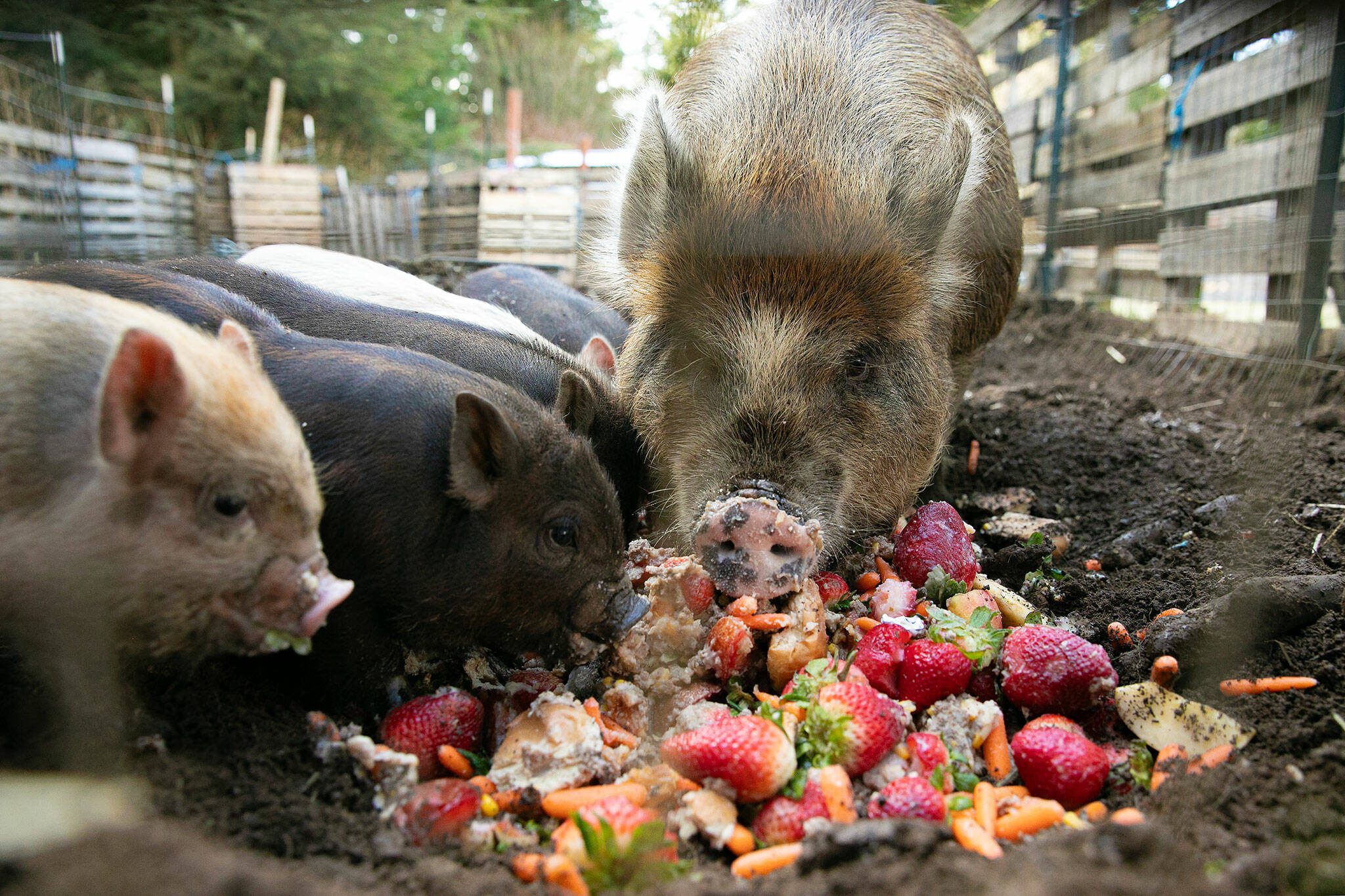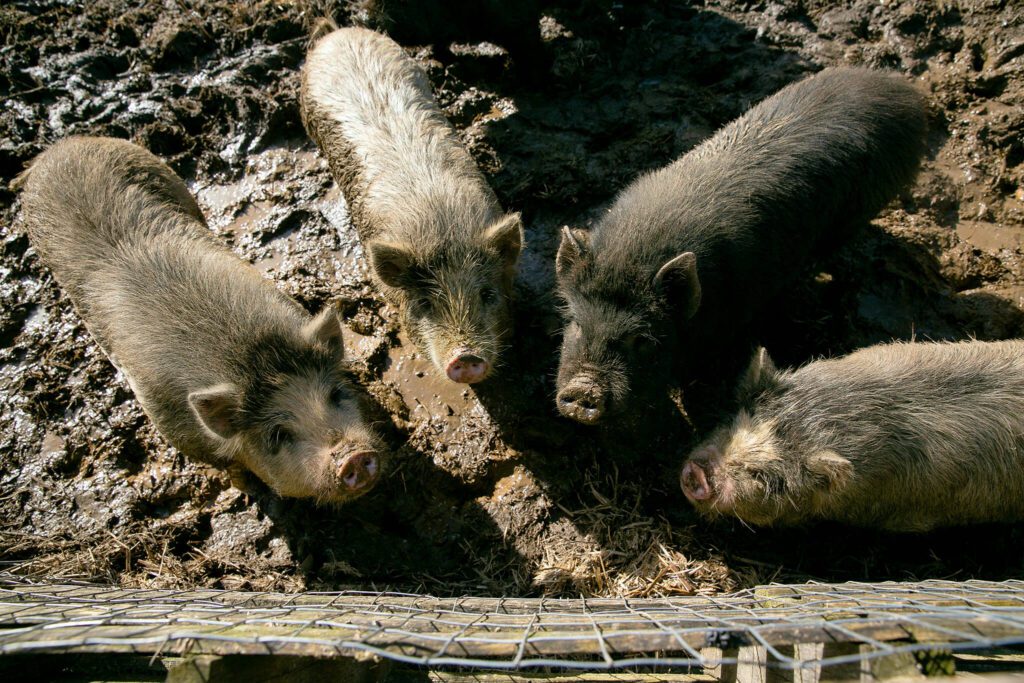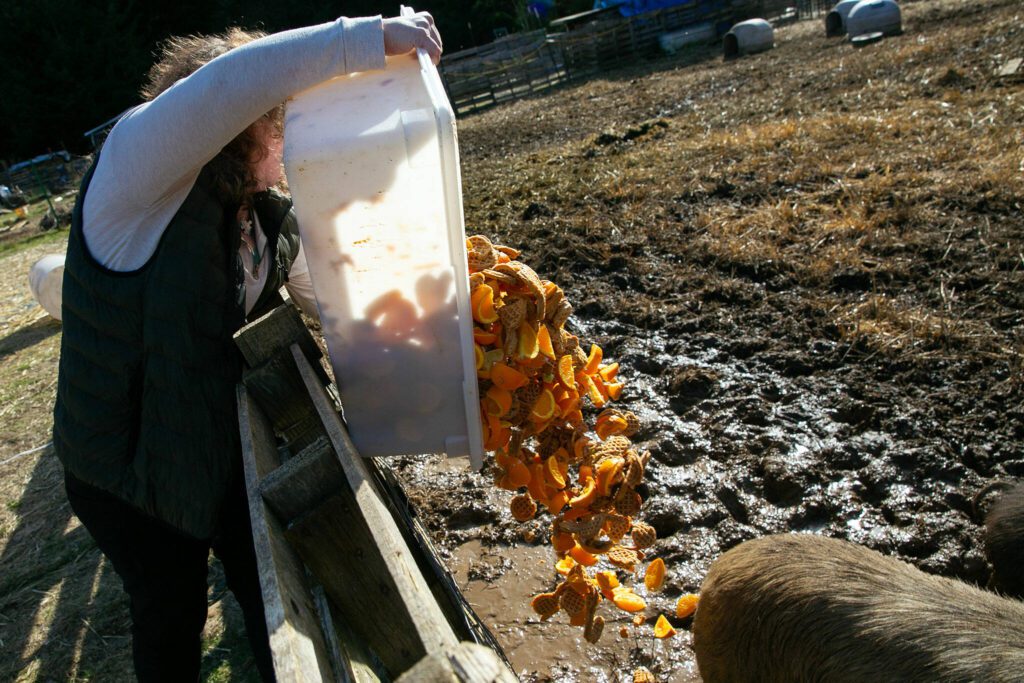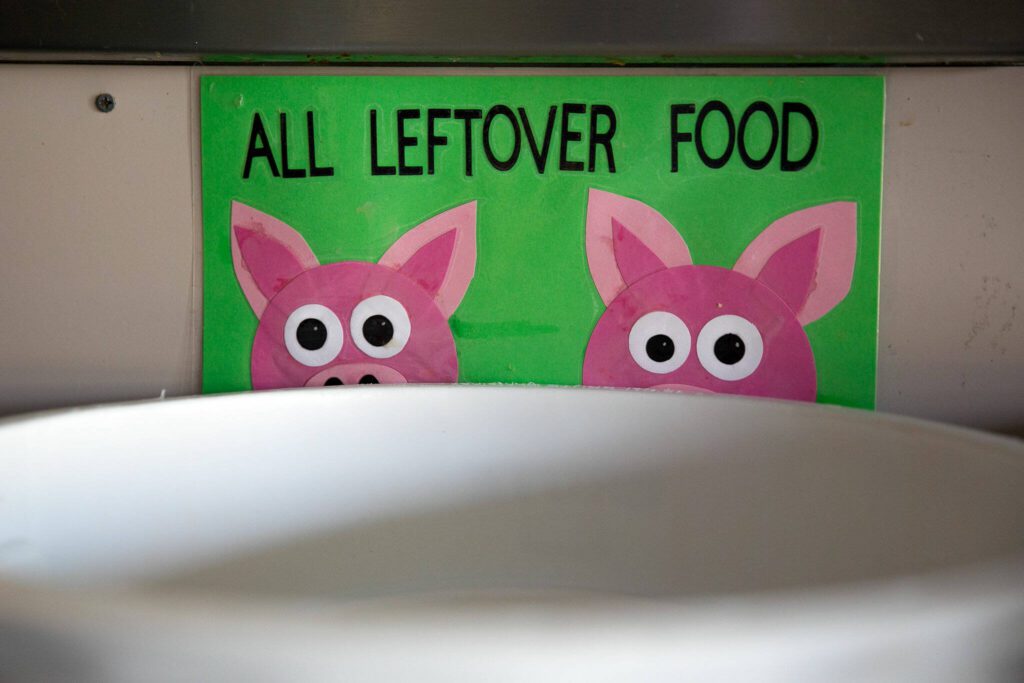DARRINGTON — After eating a meal at school, students in the Darrington School District don’t put their leftover food in the trash.
In the dining area, there is a particular bin, with a sign above it that shows pigs peeking out over the pile of scraps.
Darrington residents don’t have access to curbside compost and yard waste bins, unlike most cities in Snohomish County. Instead, the school district’s food service director, Amy Belknap, invites farmers to indulge in what she calls “a slopportunity.”
Every day after school, local farmers take turns picking up several bins filled with food scraps and bring them home to their animals — usually pigs, but sometimes chickens, goats and bunnies get a taste.
Belknap’s inspiration for starting this program over a year ago was to help the school district avoid sending food waste to a landfill. Farmers often take pictures of their animals eating the school district’s leftovers, and she shows the photos to students.
“They get to see the loop,” she said.
Washington residents typically throw away over 1 million tons of food every year. On both a local and statewide scale, staff at the state Department of Ecology are advocating for food waste reduction — a goal that could significantly reduce greenhouse gas emissions, according to Ecology.
On the Friday before St. Patrick’s Day, students in Darrington ate shepherd’s pie, bread rolls, carrots and strawberries. Eileen Guerzon, a high school special education teacher for the district, was scheduled for pickup.
“They know when the car shows up,” Guerzon said about her 15 potbelly pigs, who snorted and gathered near the wooden pallet fence of their enclosure in anticipation, soon after she parked her car.
She and her husband worked together to dump the bins inside the pens. The pigs promptly started eating, burying their snouts in mush and shoving each other for a chance to gorge.
“You name it,” Guerzon said, “they eat it.”
‘Push the envelope’
At the start of this month, local governments, nonprofits and state agencies partnered in the second annual Food Waste Prevention Week — a national campaign acknowledged last year in a proclamation by Gov. Jay Inslee.
This year, 49 states participated in Food Waste Prevention Week to promote food waste awareness through online and in-person events.
“I’m becoming convinced that this is the new Earth Day in a lot of ways,” said Jade Monroe, lead of the Washington Center for Sustainable Food Management.
(The actual Earth Day is coming up on April 22.)
In 2019, the Washington Legislature passed the Food Waste Reduction Act, outlining goals to cut total food waste, and edible food waste, in half by 2030.
Inedible food waste is generally defined as food scraps or food not prepared for consumption. Some chefs, though, have made banana peel “bacon,” as well as a new kind of mayo with aquafaba — the liquid leftover in a can of chickpeas.
“We’re trying to push the envelope a little” on some foods that are typically considered inedible, Monroe said.
Consumers can reduce their food waste in several ways:
• Make a list before grocery shopping and ensure you’re planning to buy items you don’t already have;
• Store food properly in refrigerator, cupboard and counter space;
• Understand date labels on food. “Best if used by/before” and “use by” refer to when the product will have the best flavor or quality. “Sell by” indicates when the item should be displayed for sale;
• And donate edible food.
A new state law requires residents of single-family homes in urbanized areas to separate their compost and yard waste for curbside collection by 2030.
The legislation, known as House Bill 2301, also supports food donation efforts for locals living with food insecurity. In a recent survey, almost half of the respondents said they struggled with food insecurity, according to a study conducted by researchers at the University of Washington and Washington State University.
The new law, signed by Inslee last month, tasks the Washington Center for Sustainable Food Management with providing grants to support and standardize food donation of unsold food at grocery stores, restaurants and other businesses.
Grants will also help hunger relief groups acquire equipment to transport refrigerated and frozen products to donation centers.
Composting tips
Local curbside collection services encourage residents to prepare their compost and yard waste in several ways:
• If you have an indoor compost bin, empty it every day or every other day. Clean the container at least once a week and sprinkle in baking soda to absorb odors. Line the bin with newspaper, paper towels or a paper bag to soak up moisture.
• Chill food scraps (especially from meat and fish) in your refrigerator until waste collection day.
• Layer shredded paper, food scraps and yard waste in your outdoor curbside compost bin.
WM (Waste Management), Rubatino Refuse Removal and Republic Services generally accept all food scraps, yard debris, food-soiled paper and compostable bags that comply with certain standards.
Typically, the companies prefer customers to keep the following items out of their curbside compost bins:
• Produce stickers;
• Pet waste;
• Diapers;
• Compostable service ware.
Utensils labeled as compostable often require a higher temperature to break down at compost facilities, said Heather Trim, executive director of Zero Waste Washington.
When these items are collected in curbside compost bins, whole forks, spoons and knives sometimes end up in finished compost that is otherwise ready for garden and landscaping uses.
Residents can also create their own compost area, using tips outlined by Snohomish County Public Works.
What questions do you have about recycling or composting? Email Ta’Leah Van Sistine at the address below.
Ta’Leah Van Sistine: 425-339-3460; taleah.vansistine@heraldnet.com; Twitter: @TaLeahRoseV.
Talk to us
> Give us your news tips.
> Send us a letter to the editor.
> More Herald contact information.






























